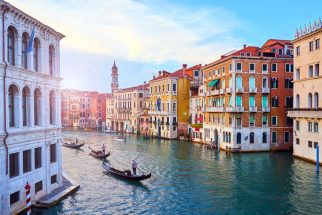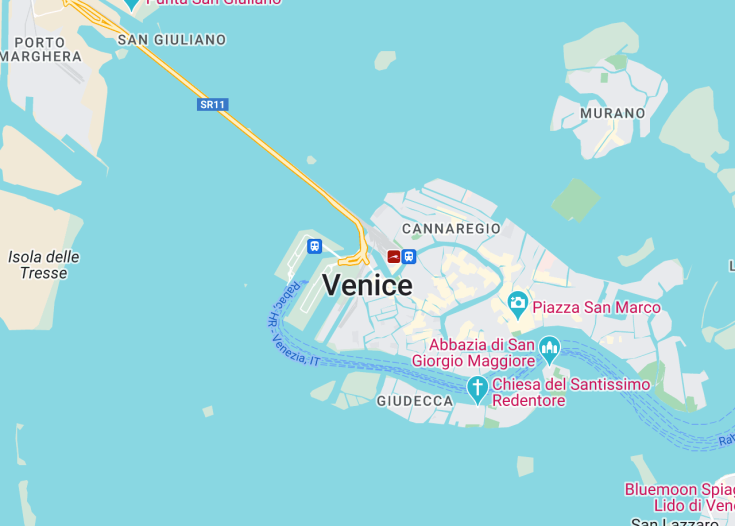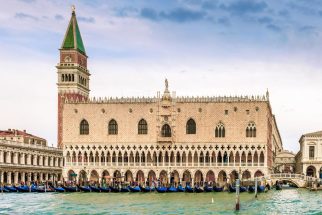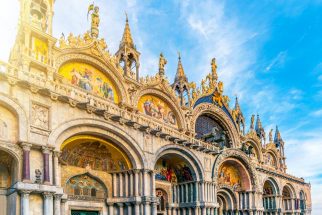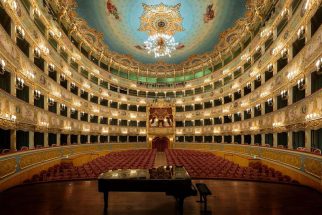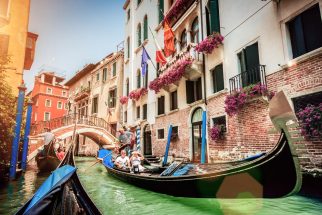Described by Lord Byron as a place of immortal beauty, Venice is an outdoor patchwork in which water, architecture and poetry create a extraordinary landscape.
Entirely built on the water of the Venetian lagoon, the city is one-of-a-kind masterpiece.
If you plan to buy a city pass, we strongly recommend not to buy the official Venezia Unica pass. It’s overcomplicated and does not give any real benefit to tourists. If you do, please do not activate the card before your first use.
Venice is quite easy to visit by foot, although you can move using the “vaporetto”, motorboats that take you along the biggest canals. Paying by single trip might be expensive. Purchasing a pass (day pass or 2, 3 and 7 days) is recomended.
Top things to do & see in Venice
Select the following sights and activities to discover best tickets and tours available in Venice.
The city of Venice
| Country | Italy |
| Region | Veneto |
| Time in Venice |
UTC+1 (CET) Summer (DST) UTC+2 (CEST) |
| Language spoken | Italian |
| Currency | Euro (€, EUR) |
| Airports |
Marco Polo International Airport (8 mi, 13 km) Venice-Treviso Airport (19 mi, 30 km) |
Entirely built on water, it consists of 118 small islands and over 400 bridges.
It is listed as a UNESCO World Heritage Site and is renowned for the canals, the small ships called “gondola” and for its Gothic and Renaissance architecture.
Where is Venice in Italy?
Venice is a city in the north east of Italy, in the Veneto region. Its small islands are in the shallow Venetian Lagoon (Laguna di Venezia), an enclosed bay lying between the mouths of the Brenta and the Sile rivers.
When was Venice founded?
Venice was founded in 421 AD when the Veneti, who had been expelled by the Ostrogoths and the Lombards after the fall of the Roman Empire, took refuge in the lagoon.
The Venice canals
Thanks to the canals, Venice is without doubt one of the most magical places to visit on earth. There are 150 canals running to Venice: the biggest one is the Grand Canal.
The Bridge of Sighs
the Bridge of Sighs (in Italian “Ponte dei Sospiri”) is an enclosed limestone bridge in Baroque style located next to the Doge’s Palace in Venice. Commissioned by the doge Marino Grimani, the bridge was designed by the architect Antonio Contino, whose uncle Antonio da Ponte designed the Rialto Bridge. According to the legend, the name Bridge of Sighs comes from the sighs of prisoners who crossed the bridge on the way to their prison cells or the excution chamber, catching their last glimpses of Venice through the tiny windows.
The Venice Carnival
The Carnival of Venice is very different to carnival which take place in Spain or in Brazil. The celebration takes place over ten days in which people dress up and take part in organized parades or simple processions on the streets. The Venice Carnival began in 1162 in celebration of the Venice Republic’s victory over its enemy: the Patriarch of Aquilea (an ancient Roman city in Italy, at the head of the Adriatic at the edge of the lagoons, about 10 kilometres from the sea). During the Venice Carnival in the past the streets were full of people wearing masks which allowed them to protect their identity and remove any social differences. Besides, masks allowed a wearer hide his identity during licentious and dissolute activities. The masks were usually made with a papier-mâché base, and then heavily embellished with fabric, feathers, fur, and gems.
Venice in literature
Since ancient times Venice has been source of inspiration for authors, poets and playwrights. The city has been the perfect backdrop for various short stories, novels, works and among these we cannot fail to mention Shakespeare‘s Merchant of Venice or Thomas Mann‘s Death in Venice.
Venice and paintings
Venice has played an important role in all types of art so it is not surprising that it has been portrayed countless times by various artists such as Tintoretto and Canaletto with his famous panoramic views of the city.
Venetian architecture
Venice has a rich and diverse architectural style, the most prominent of which is the Gothic style. Venetian Gothic architecture is a term given to a Venetian building style combining the use of the Gothic lancet arch with the curved ogee arch, due to Byzantine and Ottoman influences. The architectural styles that have characterized the city are disparate but among them are easily recognizable Renaissance, Baroque and Rococo works.
Murano glass
The glass typically made on the island of Murano near Venice is known as Murano glass. Traditionally it is made with a soda-lime “metal” and is typically elaborately decorated, with various “hot” glass-forming techniques, as well as gilding, enamel, or engraving. Production has been concentrated on the Venetian island of Murano since the 13th century. The products made of glass are precious, expertly made by the hands of expert craftmen and characterized by various colours.
Visit Venice
Best time to visit Venice
There are pros and cons to consider if you want to visit Venice between the end of spring and summer: if on the one hand the temperatures are more pleasant, on the other hand it is considered a high season with long lines for the monuments, crowds of tourists and higher housing prices. The ideal time yo avoid this is November. Some times of the year are better than others but the city can be visited all year round if you are not afraid of high water or colder temperatures.

